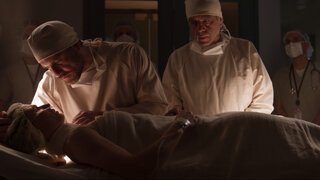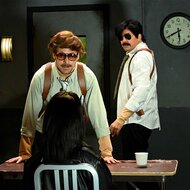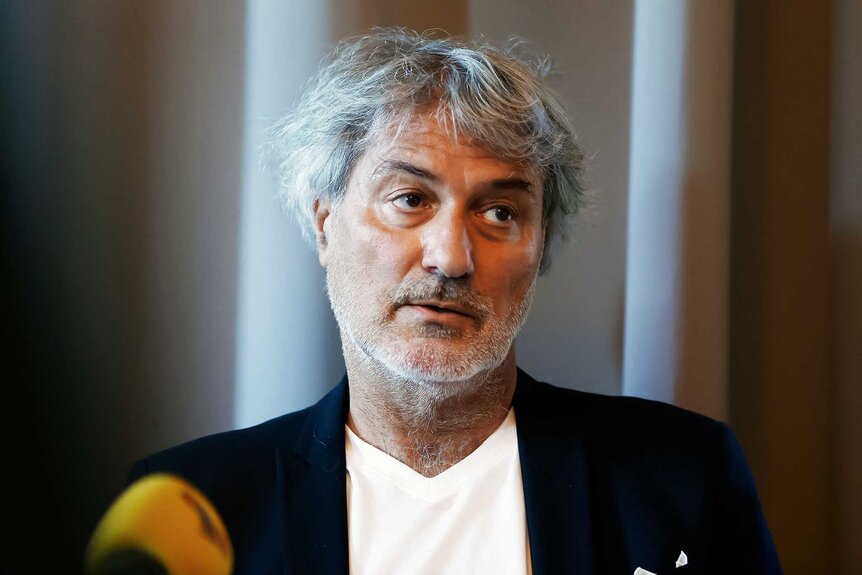Dr. Death Season 2: Dr. Paolo Macchiarini's Transplant Patients
The thoracic surgeon performed transplants on numerous patients, most of whom have since died.
The shocking second season of the Peacock original series Dr. Death has arrived, and we’re diving into the real-life stories behind the reported victims of Dr. Paolo Macchiarini.
Macchiarini, the Swedish-born Italian thoracic surgeon once considered a pioneer in regenerative medicine and stem cell research, proffered the first-of-its-kind tracheal transplant using the patient’s own stem cells. The medical research behind the procedures, however, was misleading at best, seriously inaccurate or fabricated, and likely contributed to the deaths of multiple people and several botched surgeries.
Season 2 of Dr. Death — all eight episodes are streaming on Peacock — follows the real-life story of Macchiarini (Édgar Ramírez) from the viewpoint of former NBC Producer-turned-Macchiarini’s romantic partner, Benita Alexander (Mandy Moore).
But until then, let’s learn about the individuals who found themselves under the spell (and under the knife) of the once-renowned doctor.
RELATED: A Timeline of Paolo Macchiarini's Relationship with Benita Alexander
Claudia Castillo
One of Macchiarini’s first patients to receive a tracheal transplant was 30-year-old Barcelona-based Claudia Castillo, a Columbian mother of two whose airways were damaged by a bout of tuberculosis, according to NPR. At the time, Macchiarini was head of respiratory surgery at the Hospital Clinic de Barcelona, as profiled in Castillo’s 2008 exclusive in The Daily Mail.
The concept was fairly simple to the untrained ear: To use a cadaver’s trachea, strip it of its cells, and replace the former cells with the new patient’s stem cells, typically from the bone marrow of the patient. The science aimed to prevent the rejection of a foreign body and potential years of immunosuppressive therapies (which are common in organ transplantation) once the tubular, Y-shaped respiratory organ was placed in Castillo’s body.
The procedure was carried out by Macchiarini and University College London professor and renowned E.N.T. specialist Martin Birchall.
The June 2008 transplant, cited as a breakthrough in modern medicine, was deemed successful, and Castillo even reported hitting the dance floor a few short weeks later. She told The Guardian in November 2008 that Macchiarini’s work was “a unique chance to return to a normal life that I am now enjoying with my children and family.”
She is one of a handful of patients to live through Macchiarini’s transplant, its perceived success covered by prominent media outlets, including CNN, Time, and The New York Times. But in a 2016 publication by The Guardian, Castillo reportedly “suffered extensive complications.”
In findings of a 2018 report used to retract Macchiarini’s publications in The Lancet medical journal years later, investigators wrote: “Importantly, Castillo has only survived because she had her bronchus, rather than [her] trachea, replaced by a ‘tissue-engineered’ airway, which has since been removed along with her left lung.”
Ciaran Finn-Lynch
One of Macchiarini’s other known surviving patients was a 10-year-old Northern Irish boy, Ciaran Finn-Lynch. The teen was born with a rare disorder, long-segment tracheal stenosis, and previous surgeries failed to fully repair his overly narrow airways, according to ABC News.
At the time, the University College London called the medical procedure a “world-first,” reporting the boy in fine health in 2012, two years after the tissue-engineered transplant, which had initially come from a cadaver. However, the update cited an article in The Lancet medical journal, which previously published Macchiarini’s research and later retracted his findings because they “constitute[d] scientific misconduct.”
Finn-Lynch would be the first child under Macchiarini’s care to receive the transplant, and there is nothing online to suggest that he has had any related medical complications since.
In 2013, Finn-Lynch was awarded the Pontifical Hero Award by The Vatican during the Second International Adult Stem Cell Conference in Vatican City.
Keziah Shorten
In 2010, British teen Keziah Shorten received a windpipe transplant at the Careggi Hospital in Florence, Italy, where Macchiarini was then based, according to The Telegraph. Shorten had previously been diagnosed with adenoid cystic carcinoma, a rare type of cancer that affects the trachea.
Shorten was introduced to Macchiarini’s purported success – which was then backed by the successes of Castillo and Finn-Lynch — after her uncle, an Italian translator, came across some of the doctor’s research, according to The Telegraph. But following Shorten’s return to the U.K., her new windpipe (which had also been taken from a donor) collapsed, and she wound up in the I.C.U. for months until the cancer eventually returned.
A second unsuccessful transplant took place. This time, the new trachea was not from a donor but created synthetically in a lab (a first, but not the last, for Macchiarini) nearly one year after the first surgery.
Shorten died in 2012 following the rejection of the second surgical attempt.
“Maybe I’m more forgiving than other people, but it was what it was,” Shorten’s mother, Tracy Hayter, told The Telegraph. “[She] needed the hope [Macchiarini] gave her.”
Shauna Davison
Just one month after Shorten’s death, British 15-year-old Shauna Davison, a girl born with one lung, was also the recipient of a cadaver’s trachea. Like British teen Ciaran Finn-Lynch, she was treated at Great Ormond Street Hospital, but there were differences between the procedures. For one, Davison’s cadaveric organ had been frozen and thawed, while Finn-Lynch’s was fresh from a donor, according to the BBC.
Within two weeks, while en route to another hospital, Davison struggled to breathe.
“Her chest was pulling in,” Davison’s mother, Karen Davison, told the BBC. “It was the worst day of my life because I couldn’t help her.”
Per The Telegraph, Davison’s transplant collapsed and caused irreversible brain damage. She eventually succumbed to her injuries.
Davison and her family later told reporters that they were unaware of the unsuccessful surgery of Keziah Shorten. However, Macchiarini — though he ultimately oversaw the transplant — had not directly operated on Davison, though his partner, Birchall, had.
“She was a cheeky child but loved everybody,” said her mother. “She brightened everyone’s day.”
Birchall was never charged in connection to Macchiarini’s surgeries.
Andemariam Teklesenbet Beyene
Reports indicate several more patients under Macchiarini’s care received tracheal transplants following Davison’s death, with at least one fatality. However, their identities were never revealed, and Macchiarini never saw a criminal conviction in those cases.
Zhadyra Iglikova of Kazakhstan received a transplant from Macchiarini and celebrated Moscow surgeon Vladimir Parshin at a Moscow hospital, according to Russian outlets. However, it was reported she died eight years later following the first surgery after having to undergo several more unsuccessful procedures.
While Macchiarini performed the surgery, he was not charged in connection with her later death.
But of the three patients for which Macchiarini was convicted, Eritrea-born Andemariam Teklesbenet Beyene was one of the more-known patients Macchiarini saw. At the time, Macchiarini had been recruited as a visiting professor at the Karolinska Institutet in Sweden (home of the Nobel Prize for Medicine) in 2010.
Beyene, then a 36-year-old geology grad student in Iceland, was diagnosed with tracheal cancer and had what the Iceland Review called “a tumor the size of a golf ball.”
Beyene was referred to Macchiarini and hailed as a successful recipient of a “life-saving operation,” as reported in NPR and CBS News. The 2011 transplant, unlike those of Castillo and Finn-Lynch, used a plastic, lab-grown device, as opposed to one from a donor, which was also treated in the recipient’s own stem cells.
This synthetic device would be used in Macchiarini’s future surgeries as well.
“I was almost dead,” Beyene told The New York Times. “There was suffering. A lot of suffering.”
However, in 2014, three years after the operation, the implant loosened, and Beyene died as a result. Also factored into his death was a subsequent “series of infections” he’d encountered post-surgery, according to the BBC.
An investigation into Beyene’s death, as detailed in the new Peacock series, showed Macchiarini acted without the approval of the Swedish medical ethics committee, as was required. At the time, scholars also began to poke holes in Macchiarini’s research published in The Lancet.
Christopher Lyles
Next was 30-year-old Christopher Lyles, an electrical engineer for the Department of Defense from Abingdon, Maryland, and the first of Macchiarini’s American patients to receive the transplant. Lyles was diagnosed with cancer but said he was “thankful for a second chance on life” after his family saved money for the surgery, which took place in November 2011 at the Karolinska Instituet in Sweden, per The New York Times.
“It’s just basically an experimental surgery,” Lyles told NBC Baltimore affiliate WBAL-TV. “I just had to do it to save my life.”
Lyles’ operation took place after Beyene’s, though Lyles died first. In March 2012, after returning from Sweden, Lyles died at a Baltimore hospital, though an official cause of death was never revealed.
Macchiarini would later be charged with manslaughter for the cases of Beyene and Lyles, but since their initial diagnoses were terminal, criminal charges were replaced with aggravated assault. Intent could not be established, and he was convicted on one charge of causing severe bodily harm instead.
The Baltimore affiliate reported that the Karolinska Institutet sent Lyles’ family a letter of apology following his death, though relatives maintained Lyles’ decision to undergo the procedure — given the terminal prognosis of his cancer — was the right choice.
Macchiarini’s Surgeries in Russia
Before the Karolinska Institutet declined to renew Macchiarini’s contract in 2013 (they later found him guilty of scientific misconduct), he traveled to Russia that same year. There, he performed the transplant in four separate operations involving the failed synthetic trachea devices.
By June 2012, Macchiarini was still praised as a medical hero when 33-year-old Russian mother and dancer Yulia Tuulik opted to have the transplant following a car accident (which occurred when Yulia was still pregnant) and required a tracheotomy. Her story was covered as part of a Swedish documentary, The Experiments (Experimenten).
That same month, Macchiarini performed the synthetic transplant on another car accident victim, Aleksandr Zozulya. Like Tuulik, Zozulya also elected to undergo the transplant and was reliant on a tracheotomy.
Neither surgery was a matter of life and death, as was the case in Macchiarini’s previous subjects.
Both patients were dead by 2014, though the second patient reportedly died after a bicycle accident led to internal blood loss from “an area unrelated to the trachea.”
Despite Macchiarini citing the Russian patients’ stories as nothing short of a triumph, Science reported that Tuulik’s new trachea ultimately collapsed, and a subsequent transplant also failed her.
Both instances took place at Krasnodar Regional Hospital, about 800 miles south of Moscow.
Allegations against Macchiarini were largely perceived as an affront to the state of Russia, which made allegations against Macchiarini difficult to establish.
He has not been charged in connection with any of the surgeries performed in Russia.
Yesim Cetir
Another tragic case belonged to 25-year-old Turkish university student Yesim Cetir. Turkish surgeons mistakenly nicked Cetir’s trachea after she underwent a routine procedure to correct sweating palms, according to ABC News. She was referred to Macchiarini at the Karolinska Institutet for the elective, bioengineered transplant. However, Macchiarini would remove one lung and perform two transplants on the young woman: one in 2012 and another in 2013.
As a direct result of the botched transplant(s), Cetir underwent 191 additional surgeries as problem after problem presented itself, said family attorney Rosemary Pinto.
“She had suffered at least two strokes; she had lost much of her vision, so she was partially blind; she couldn’t walk,” Pinto told ABC News.
A panel of judges in the Swedish court later ruled Macchiarini was “indifferent” to the health risks posed by the surgery, according to Science. Cetir’s new doctors also found Macchiarini falsified the results of past patients, including a report where Macchiarini stated the implant in his “first patient” developed wonderfully, when in fact, fungus was found in the transplant and one of the patient’s lungs “was completely obliterated from a chronic infection.”
Macchiarini also claimed one of his patients was still alive, despite the patient dying before the publication, according to ABC News.
Cetir died in a Philadelphia hospital in 2017. According to Swedish media outlet SVT Nyheter, she was the fifth recipient of Macchiarini’s plastic transplant.
Hannah Warren
The youngest of Macchiarini’s transplant recipients was Korean-Canadian toddler Hannah Warren, who was just 2 when in Macchiarini’s care. Warren was born without a trachea, a rare condition with a 99% mortality rate, according to CNN.
Warren spent every day of her life hospitalized until the experimental surgery took place on April 9, 2013, at the Children’s Hospital of Illinois.
The child died less than three months later.
“Our hearts are broken,” the family wrote on a blog cited by CNN. “We will forever miss her infectious personality and miraculous strength and spirit… she is a pioneer in stem cell technology, and her impact will reach all corners of our beautiful earth.”
Prior to the surgery, Macchiarini gave loved ones — and the medical community — much hope about Warren’s chance at life and breaking new ground in the world of stem cell research.
Ahead of the surgery, Macchiarini said, “She will go from being a virtual prisoner in a hospital bed to running around and playing with her sister and enjoying a normal life, which is a beautiful thing,” according to ABC News.
Warren was one month shy of her third birthday when she passed away.
Sadiq Kannan, Dmitri Onogda
Two more recipients also underwent the synthetic transplants, though they weren’t nearly as publicized as some of Macchiarini’s previous patients. Sadiq Kannan, of Jordan, had the transplant in 2013 but died sometime later, according to Radio Free Library’s Russian Service.
One Russian outlet noted that Kannan was a doctor whose windpipe had been badly damaged 20 years earlier from a horrific car crash, resulting in artificial ventilation and tracheal stenosis.
The procedure — like Tuulik and Zozulya — took place in Russia’s Krasnodar Regional Hospital, though no charges were pressed against Macchiarini.
Around this time, scrutiny against Macchiarini grew, though he was still permitted to practice medicine.
In 2014, Crimean man Dmitri Onogda also had the surgery but he reportedly survived after the transplant was taken out, according to a 2016 article by the BBC. It remains unclear if there has since been an update in his health, though according to Experimenten, Onogda’s new organ never functioned.
Kannan and Onogda are included in the list of Macchiarini’s nine plastic transplants, which consisted of Shorten (as used in her second transplant), Beyene, Lyles, Tuulik, Zozulya, Cetir, and Warren.
See more about Dr. Paolo Macchiarini and his past patients in the all-new season of Dr. Death, and the companion documentary Dr. Death: Cutthroat Conman, on Peacock.




































